“I have so much empathy for every little piece of crap,” admits Sophie Jung during a pre-performance chat as we walk barefoot through her exhibition The Bigger Sleep – Rehush (hush) in the basement of a vacant and eerie west London space. Occupied by Cork Street Galleries for Block Universe Festival—which ran from May 19 to June 1—the work is a site-specific installation and performance adapted from the Swiss artist’s premiere at Basel’s Kunstmuseum Gegenwart in 2018.
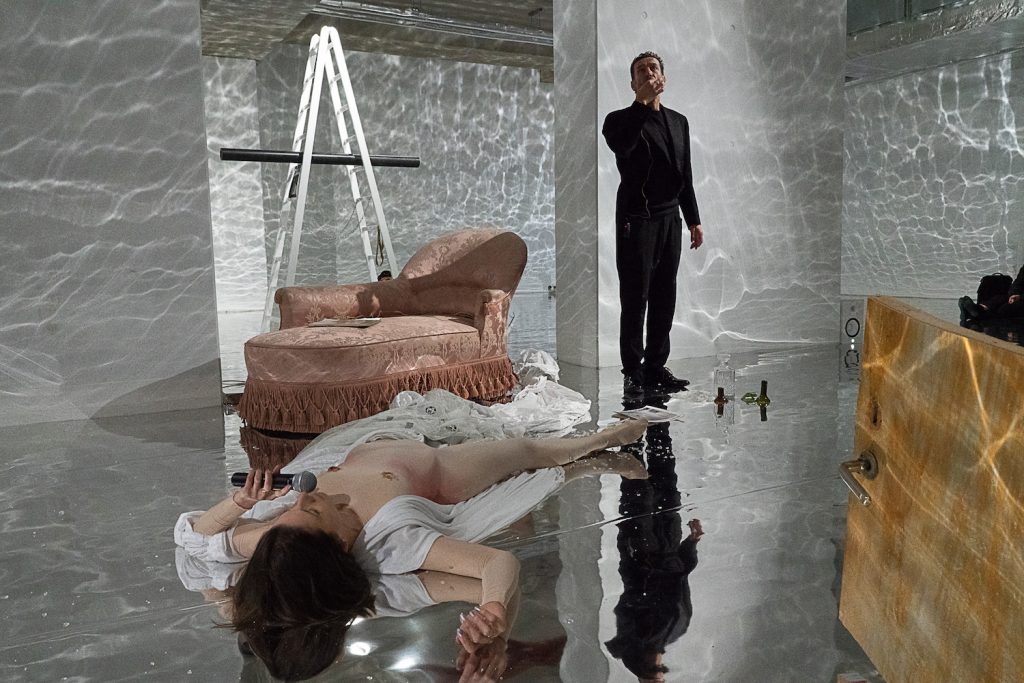
The soft mirrored floor and low lighting cast waves that glisten across the walls—a sexy yet transparent backdrop for her sculptures or self-described suggestions, “I don’t want them to arrive at a definite form, even if it’s a great form. Ideologically I don’t want anything to be fixed or finished in that conclusive way.” Pointing at the various ‘things’ around the space—inflatable blue plastic hangers turned dolphins balancing on a copper pole stuck into a film reel, a dead fly laid upon a miniature clay sofa that sits upon a stool made of tinfoil encircled by a ring of gravel fishbones from Salton sea’s shore—Jung gives me the multitude of backstories that run through them, “They can’t be too stable in themselves, all their elements have moments with other elements within an archive of material solidarity—a mood, you could say, the constituting of which, the process of intentional finding, is a large part of my practice. They regularly come upon new temporary partners, interim constellations within a grander system of belonging and semantic support.”
When I ask her about Peter’s role in all this (the man who plays a somewhat nameless butler in her performances as well as being her life partner) she describes him as something akin to a personal assistant, “he makes it all possible, he drives me to the flea markets, helps me carry large sheets of metal I happen to find on the street, proofreads my texts, gets on stage when the work calls for it and cooks me food when I forget to eat. When we’re on a scavenging mission I get an image of myself as, say, Anna Wintour with her PA—I scan for bargains and send him out with unbiased haggle instructions ‘those maybe but no more than €5, this, max of €20, etc.’”
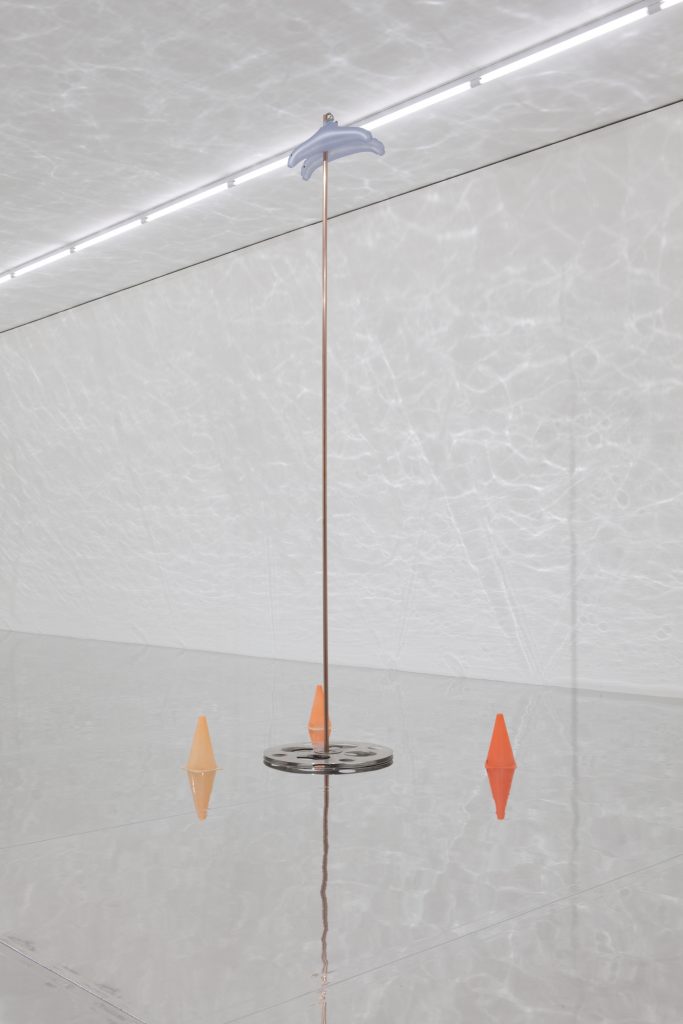
Aside from help in collecting the bits, I’ve noticed a shift in collaborative agency and am curious to know when ‘Sophie Jung’s assistant’ became ‘Peter Burleigh.’ Laughing, Jung agrees and tells me this is a recent development, “for ages he didn’t want anything to do with it, or any credit (because he’s got his own job). Now only recently he’s been a bit like [diva gestures] and then two days ago he suddenly just started ad libbing in the performance. He did his own things, had a few jokes.” The audience do love Peter. “He’s like the barometer. Without him, nothing would happen, nothing would be possible, but at the same time, it is important to him to have it known that he doesn’t make any of the creative decisions, that it’s my work. It’s not that one thing [the creative process] is more important than the other [logistics, organisation and support]. I need him, he is essential to my practice, being my activating witness when I scramble for form or meaning through the heaps of junk and piles of treasures I try to transform.”

I take my seat on the floor with the rest of the audience as the hour long performance is about to begin. As with previous works, I’m expecting it to be hyper and lively, energetically shifting from one topic to the next. While this structure of performativity is still there, it now moves along at the pace of a shrug. Dragged around like a heavy body, the performance feels bored of itself and of it’s pathetic attempts at luxury. It lives up to its title which was chosen in reference to Raymond Chandler’s 1939 crime novel The Big Sleep, meaning death. “The bigger sleep is purgatory” Jung explained earlier, “I wanted to get this mood of seemingly inescapable limbo, sustained by this unanswered and infinitely evaded question of accountability. The Bigger is not starting or ending, but stuck in eternal growth [shuddering].”
An audio recording of someone whistling the ‘Battle Hymn of the Republic’ plays throughout, creating a tone of what Jung describes as faded glory, “What was once considered heroic has now been left lying in the cupboard for too long, dusty and unconvincing. What once had conviction in this classic narrative of good and bad is now brokenly whistled from the breath of deep sighs.” Peter walks around the space, rearranging the sculptural elements without purpose. Jung lays on a chaise longue in the centre of the room, reading shallow advertisements to the audience from a 1980s architectural digest—an era where public tales of unapologetic decadence were en vogue.
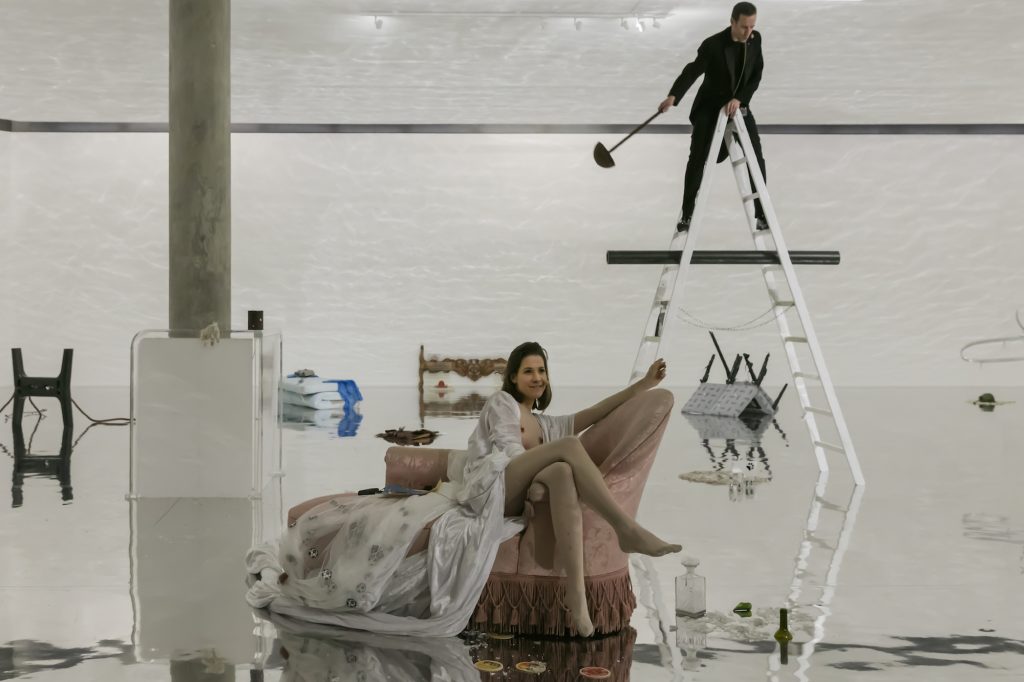
Unsure of whether he is a servant to this glamorous protagonist, or whether they are in the boring throes of a monogamous relationship killing time in a make-shift mansion, their interaction is strange; they speak to, at and over each other, sometimes engaged in conversation, sometimes just speaking at the same time. Is that all there is? He asks, passing her an imaginary bourbon, Yes that’s all there is she answers, then asking the audience Is that all? Jung continually moves the conversation between acting and directing, Isn’t it beautiful? The choir of discontented voices all together and in harmony…hey, i know, why don’t you feed them waffle? she instructs. Why don’t I just give them the waffle iron? he answers, walking up to people and offering waffle? from a Millenium Falcon spaceship (of Star Wars) that opens like a waffle maker. I worked hard for that ship, she replies.
He addresses her as Frau Welt—a reference to a medieval allegory who is often personified on cathedrals. From the front, she is a young woman facing life in full bloom and from the back, her coat is open and you see her organs rotting and being eaten by maggots. “That was my image of the situation,” Jung later tells me, “very film noir-esque. Like the shiny veneer of the American Dream, but underneath is the rotten underbelly of corruption propping it up. It’s basically a plump metaphor for the capitalist desiring machine.”
Neither young or old, dead or alive, her indeterminate age reflects this non-time space of the performance, or as the butler says, “Now O’Clock”, as he swings a giant ladle back and forth like a clock hand. A looping of vacuous longing, of unfulfillable desires play out, stranger each time in moments of semantic satiation. “I suppose the loop is not really a loop but more an ongoing spiral,” Jung adds. “A loop keeps coming back and tracing the same lines but, like with semantic satiation [when a word loses its meaning through repetition, becoming unfamiliar], you end up at a different point.” Jung reiterates that it is this constant reconnecting through estrangement that allows for unresolvable ambiguity and (un)comfortable hovering above exclusionary borders of categorisation. “It is about holding concepts far enough away so you can look at them in their supposed entirety, with all their major and minor voices, big and small, relevant and irrelevant—not possessing them through fixed, fixing or fixated meaning.”
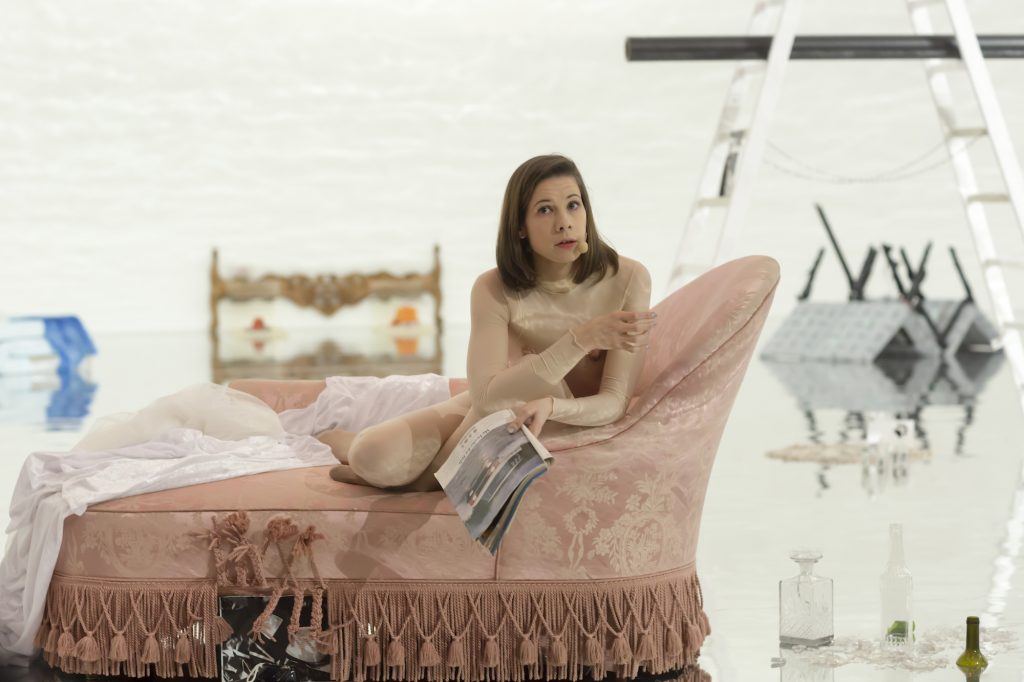
Our interview continues over the coming days through voice notes to each other. Lying in bed, I ask her if she’s tired—at this point I’m more interested in the factors going on behind this paralysed performance. “It [the show] definitely came out of a state of emotional and physical dullness, where all the anger and excitement and fury and hysteria that I managed to bring to my previous performances seemed to be completely unreachable and just out of the question. I tried to figure out what this feeling was or this mood that I was in. Although it was isolated in my body and my mental health, I felt like it was a feeling that was shared on a collective level—a strange mix of guilt, panic and grief – but not lived grief, more anticipatory grief or mourning. You know the worst is going to happen, and you’re just waiting for it to happen in this endless, expanded presence that you’re in.”
We carry on talking about more depressing and incomprehensible things, like the rapid loss of 60% of wildlife at the rate of (according to some sources) 200 species per day and as Jung notes, the continued worshipping of an economic model based on growth through oppression and an arbitrarily aligned distribution of voice, respect and power. “The fact that we’re all fastened to this destructive system and nobody, no one action by one entity—the individualist tenet of “sorting it alone” we’ve all grown up with—can really think of a course of action to bring about visible change. Yet we have lost trust and understanding in collective forces. This leaves us hovering in an anxious limbo that can’t seem to be snapped. How stagnatory or delusional can a collective reality get if this is one of the markers of how we go about daily life, with this unresolved trauma at the back of our minds…”
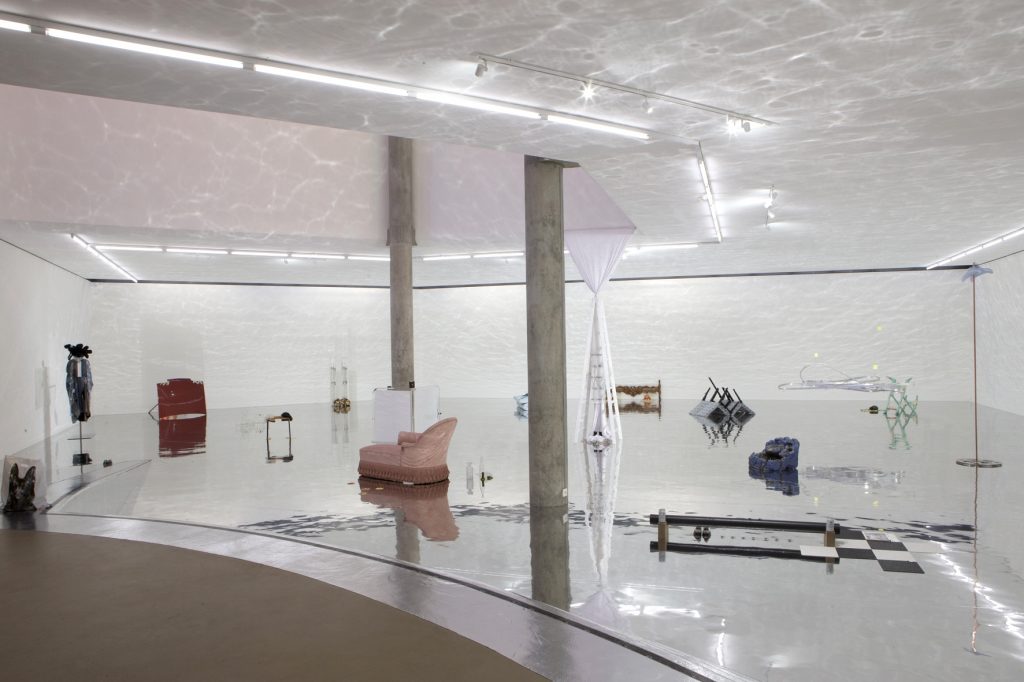
This pervasive exhaustion doesn’t necessarily feel born out of nihilism but maybe the combination of caring deeply, hope in collective resistance and feeling utterly powerless. Or at least this is how Jung’s tone feels. No rising action, climax or denouement, just a performance that didn’t really want to be performing itself—an honest and raw space of lethargy. “Anyway, all of that fit the state that I was in. I couldn’t see how anyone could ever be happy again given the situation, yet I didn’t feel sad I just felt numb at a very high frequency. In a way it describes a societal state and also my own state of mind—this feeling of not feeling and knowing you should be feeling and all you can muster is a heavy shrug or something.”
While the work, and Jung’s approach, certainly doesn’t feel nihilistic, I’m still interested in where she places herself between the meaningful and the meaningless. “My job is to take things, concepts, conditions and structures and make them strange, to have them interlock with things they normally wouldn’t interlock with, so the hinges to neighbouring concepts become strange too.” Jung never allows anything (a word, an object, a narrative, a structure) to settle for too long in one place before it is re-arranged, before it can begin to make sense in our minds—a constant point of departure that she describes as a daily meditation rather than a one time detox. It is here that The Bigger Sleep occupies something more incessant than the finalities of defeat or hope and more of a constant re-thinking and becoming that Jung describes as “a sort of principle or ideology which stops you from settling into conditioned preconceptions. If practiced regularly it is a potent action against discrimination and ultimately fascist tendencies. Meaning is never internal to objects, conditions or structures, it is always attached and made up of many prejudices. In this way I’m the messenger between meaningful and meaningless, but the meaningless is definitely not the end position but the starting point for recalibration, a constant intermediate between supposed knowledge and authenticated discovery.”**













